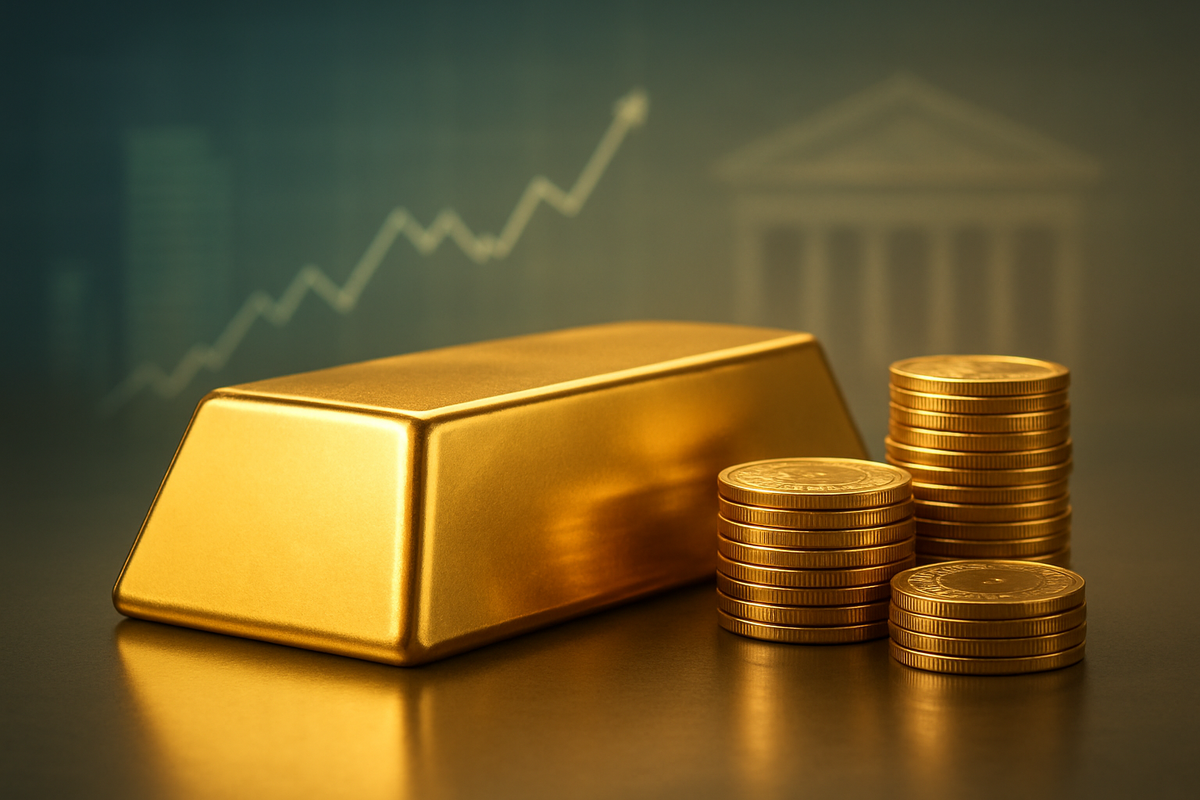
Gold prices are currently experiencing a significant upward trajectory, reaching multi-week highs as investors eagerly anticipate the Federal Reserve's upcoming monetary policy decision. While some initial observations might have suggested a period of stability, the precious metal has in fact been demonstrating robust upward momentum, driven by strong market expectations of an imminent interest rate cut. This surge reflects a profound shift in investor sentiment, as market participants position themselves for a potentially more dovish stance from the U.S. central bank, making non-yielding assets like gold increasingly attractive.
The prevailing sentiment points to a high probability of the Federal Open Market Committee (FOMC) enacting a 25-basis-point rate cut at its December 9-10, 2025 meeting. This expectation, largely fueled by signs of a cooling U.S. labor market and global economic uncertainties, is weakening the U.S. dollar and enhancing gold's appeal as a safe haven and a hedge against potential currency debasement. This dynamic is not merely a short-term fluctuation but a reflection of deeper market forces at play, with analysts projecting continued bullishness for the yellow metal into the coming years.
Anticipation Builds for a Dovish Federal Reserve
The financial markets are fixated on the upcoming Federal Open Market Committee (FOMC) meeting scheduled for December 9-10, 2025. This pivotal gathering is widely expected to culminate in a significant monetary policy shift, with a high probability—around 68-70%—of a 25-basis-point reduction in the federal funds rate. This potential cut would move the target range from its current 4.25%–4.50%, a level maintained since December 18, 2024. The anticipation of this dovish pivot is the primary catalyst behind gold's recent rally, transforming what might have been a period of steady prices into a robust upward trend.
Leading up to this moment, a series of economic indicators has bolstered the case for monetary easing. Notably, recent U.S. labor market data, including private payroll reports, have signaled a softening economy. This cooling labor market, coupled with broader global economic uncertainties, provides the Federal Reserve with ample justification to consider a rate cut. Key players, including Fed Chair Jerome Powell and other members of the FOMC, have been closely scrutinizing these economic signals, with their public statements and nuanced communications influencing market expectations. The timeline of events has seen gold rebound strongly from an October correction, where it briefly touched an all-time high of $4,381.58 to $4,530.00 per ounce before consolidating, only to resume its ascent in November.
The market's initial reaction to these expectations has been overwhelmingly bullish for gold. The precious metal has gained approximately 7% over the past five trading sessions, pushing it back to levels not seen since late October. This surge is also correlated with a weakening U.S. dollar, which typically makes gold more affordable for international buyers, further fueling demand. Beyond speculative trading, persistent central bank buying, particularly from emerging markets, continues to provide a strong fundamental floor for gold prices, reinforcing its role as a strategic reserve asset.
Public Companies Poised for Gains or Losses
The Federal Reserve's anticipated interest rate cut carries significant implications for various public companies, creating both opportunities and challenges across different sectors. Gold mining companies, in particular, stand to be major beneficiaries of sustained high gold prices. Companies like Barrick Gold Corporation (NYSE: GOLD), a prominent global gold producer, and Newmont Corporation (NYSE: NEM), the world's largest gold company, are likely to see increased revenue and profitability. Higher gold prices directly translate to better margins for these miners, potentially leading to improved financial performance, increased exploration budgets, and higher shareholder returns. Investors looking at these companies will be scrutinizing their operational efficiencies and hedging strategies in this environment.
Conversely, companies that thrive in higher interest rate environments or are highly sensitive to currency fluctuations might face headwinds. Financial institutions, particularly regional banks, which often benefit from wider net interest margins when rates are higher, could see some pressure on their profitability. While not directly impacted by gold, a weaker dollar, a consequence of lower rates, could affect companies with significant import costs or those that repatriate earnings from stronger currency regions. However, for many U.S. multinational corporations, a weaker dollar can make their exports more competitive globally.
Furthermore, the broader economic impact of a rate cut could influence consumer spending and investment. Retailers and consumer discretionary companies might see a boost if lower borrowing costs encourage consumer spending. Conversely, companies heavily reliant on debt financing might find some relief, as their interest expenses could decrease. The technology sector, often sensitive to interest rates due to its growth-oriented nature and reliance on future earnings projections, could also see renewed investor interest as lower rates reduce the discount rate applied to future cash flows, making their valuations more attractive.
Wider Significance: A Shift in the Economic Landscape
The Federal Reserve's anticipated monetary policy shift extends far beyond the immediate impact on gold prices, signaling a broader recalibration of the economic landscape. This move fits into a wider industry trend of central banks globally moving towards more accommodative policies in response to slowing growth and persistent, albeit contained, inflation concerns. The aggressive rate hikes of previous years aimed at curbing inflation are now giving way to a more dovish stance, reflecting a nuanced approach to economic management that prioritizes sustaining economic activity while still monitoring price stability.
The potential ripple effects on competitors and partners are substantial. A weaker U.S. dollar, a likely outcome of rate cuts, could enhance the competitiveness of U.S. exports, benefiting manufacturing and technology companies that operate on a global scale. Conversely, countries with strong trade ties to the U.S. might experience shifts in their own currency valuations and trade balances. In the commodities market, the weakening dollar typically supports other dollar-denominated assets, potentially boosting prices for oil and other raw materials.
From a regulatory and policy perspective, a rate cut signifies the Fed's assessment of current economic health and its proactive measures to prevent a deeper downturn. This policy shift could influence future fiscal policies, potentially encouraging government spending or tax adjustments designed to complement monetary easing. Historically, periods of sustained central bank gold accumulation, as observed currently, often precede or coincide with significant economic uncertainty or shifts in global financial power dynamics. Comparisons to similar events in the past, such as periods following major financial crises or economic slowdowns, suggest that gold tends to perform strongly when real interest rates are low or negative, making the current environment particularly favorable for the precious metal.
What Comes Next: Navigating the Evolving Market
Looking ahead, the short-term focus will undoubtedly be on the Federal Reserve's actual decision on December 9-10, 2025. A 25-basis-point rate cut, as widely anticipated, is likely to further propel gold prices, potentially pushing them towards the $4,500-$4,700 range projected by analysts from institutions like JPMorgan and Wells Fargo for 2026. In the immediate aftermath, market volatility might increase as investors fully digest the implications of the Fed's statement and any forward guidance provided by Chair Powell. Short-term possibilities also include continued pressure on the U.S. dollar and a potential rally in equity markets, particularly for growth stocks.
In the long term, the trajectory of gold prices will hinge on the sustained dovishness of the Fed, the pace of subsequent rate cuts, and the broader global economic environment. Should the Fed embark on a sustained easing cycle, as some analysts predict, gold could even breach the $5,000 mark by the end of 2026. This scenario would require strategic pivots from investors, potentially rebalancing portfolios to increase exposure to precious metals and other inflation-hedging assets. Market opportunities may emerge in gold-backed ETFs, gold mining stocks, and even physical gold. Challenges could include unexpected inflationary pressures that force the Fed to reverse course, or a stronger-than-anticipated economic recovery that reduces safe-haven demand.
Potential scenarios range from a "soft landing" where the Fed successfully engineers a slowdown without triggering a recession, leading to moderate gold gains, to a more aggressive easing cycle in response to a deeper economic downturn, which would likely send gold soaring. Investors should closely monitor upcoming economic data, including CPI reports, employment figures, and geopolitical developments, as these will be crucial in shaping the Fed's future decisions and, consequently, gold's performance.
Comprehensive Wrap-up: Gold's Enduring Appeal in a Shifting Landscape
In summary, the current surge in gold prices is a direct reflection of heightened investor anticipation for a Federal Reserve interest rate cut in December 2025. This move, driven by a cooling U.S. labor market and global uncertainties, is expected to weaken the U.S. dollar and decrease the opportunity cost of holding non-yielding assets, making gold exceptionally attractive. Key takeaways include the robust performance of gold, the strong consensus around a 25-basis-point rate cut, and the significant implications for gold mining companies and other rate-sensitive sectors.
Moving forward, the market is poised for continued volatility and strategic repositioning. Gold's enduring appeal as a safe haven and a hedge against economic uncertainty and currency debasement is being reinforced by central bank buying and a broadly bullish investor sentiment. While the immediate focus is on the December FOMC meeting, the longer-term outlook for gold remains strong, with potential for further gains into 2026.
Investors should watch for the actual announcement from the Federal Reserve, paying close attention to the language used in the accompanying statement and any press conferences. Subsequent economic data releases will also be critical in shaping future monetary policy decisions. The current environment underscores the importance of a diversified portfolio, with gold potentially playing a crucial role in mitigating risks and capturing opportunities in an evolving global financial landscape.
This content is intended for informational purposes only and is not financial advice





